Client state
A client state is a state that is economically, politically, or militarily subordinate to another more powerful state (termed controlling state in this article) in international affairs.[1] Types of client states include: satellite state, associated state, puppet state, neo-colony, protectorate, vassal state, and tributary state.
Controlling states in history
Persia, Greece, and Rome
Ancient states such as Persia and Parthia, Greek city-states, and Ancient Rome sometimes created client states by making the leaders of that state subservient, having to provide tribute and soldiers. Classical Athens, for example, forced weaker states into the Delian League and in some cases imposed democratic government on them. Later, Philip II of Macedon similarly imposed the League of Corinth. One of the most prolific users of client states was Republican Rome[2][3] which, instead of conquering and then absorbing into an empire, chose to make client states out of those it defeated (e.g. Demetrius of Pharos), a policy which was continued up until the 1st century BCE when it became the Roman Empire. Sometimes the client was not a former enemy but a pretender whom Rome helped, Herod the Great being a well-known example. The use of client states continued through the Middle Ages as the feudal system began to take hold.
Under the Mongols and the Yuan dynasty
In the 13th century, Goryeo dynasty of Korea was overrun by the Mongols who founded the powerful Mongol Empire. After the peace treaty in 1260 and the Sambyeolcho Rebellion in 1270, Goryeo became a semi-autonomous client state of the Yuan dynasty for about 80 years.
Ottoman Empire
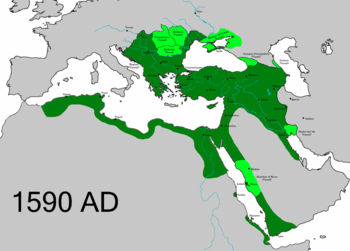
The number of tributary or vassal states varied over time but notable were the Khanate of Crimea, Wallachia, Moldavia, Transylvania, Sharifate of Mecca and the Sultanate of Aceh.
19th and 20th centuries
Russia and Serbia
The Austro-Hungarian Empire tried to make Serbia a client state in order to form a Christian opposition to the Ottoman Empire. That changed after a revolution in Serbia in 1900. Serbia now came under Russian protection, which was forming a pan-Orthodox opposition to the Latin Christianity represented by the Austro-Hungarian empire. In 1914, Russia repeatedly warned the Austro-Hungarian Empire against attacking Serbia. When it did attack, Russia mobilized its army.[4][5][6] Russia also wanted Bulgaria[7] and Montenegro[8] as client states.
Great Britain and Austria both considered Serbia as a client state controlled by Russia.[9] Most historians call Serbia a client state but historian Christopher Clark disagrees. He says the Russians made a mistake in thinking Serbia was a client state. In an unpublished commentary Clark argues:
"It was a risk enhancing initiative [of Russian Foreign Minister Serge Sazanov]
to allow Serbia to becometo see Serbia as a kind of client; ... Serbia, to my knowledge, has never been a client of anyone. [...] This is a mistake, when Great Powers think they can secure the services of "client states";ThatThose "clients" are never in fact "clients"! That's a mistake that is presumably going to continue being made by our political leaderships, though one hopes one day it will stop."[10]
France
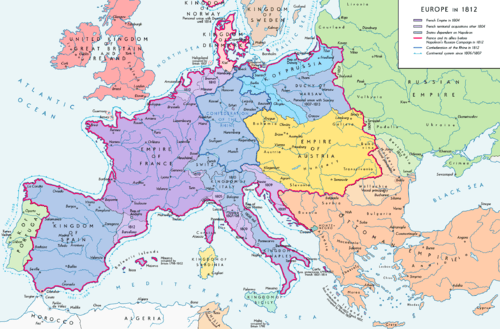
During the Revolutionary and Napoleonic eras (1789–1815), France conquered most of western Europe and established several client states. At first, during the French revolutionary wars these states were erected as republics (the so-called "Républiques soeurs", or "sister republics"). They were established in Italy (Cisalpine Republic in Northern Italy, Parthenopean Republic in Southern Italy), Greece (Septinsular Republic), Switzerland (Helvetic Republic and Rhodanic Republic), Belgium and the Netherlands (Batavian Republic).
During the First French Empire, while Napoleon and the French army conquered Europe, such states changed, and several new states were formed. The Italian republics were transformed into the Kingdom of Italy under Napoleon's direct rule in the north, and the Kingdom of Naples in the south, first under Joseph Bonaparte's rule and later under Marshal Joachim Murat. A third state was created in the Italian Peninsula, the Kingdom of Etruria. The Batavian Republic was replaced by the Kingdom of Holland, ruled by Napoleon's third brother, Louis Bonaparte.
A total of 35 German states, all of them allies of France, seceded from the Holy Roman Empire to create the Confederation of the Rhine, a client state created to provide a buffer between France and its two largest enemies to the east, Prussia and Austria. Two of those states were Napoleonic creations: the huge Kingdom of Westphalia, which was controlled by Jerome Bonaparte, the Emperor's youngest brother; and the Grand Duchy of Würzburg.
Following the French invasion of the Iberian Peninsula, Spain too was turned into a client Kingdom of Spain under Joseph Bonaparte; as was Poland, then the Duchy of Warsaw.
In the 20th century, France started to apply the concept of Françafrique, its name for its former African colonies,[11][12] sometimes extended to the former Belgian colonies. At present the term is used on some occasions to criticise the allegedly neocolonial relationship France has with its former colonies in Africa.
The countries involved provide oil and minerals important to the French economy. In addition, French companies have commercial interests in several countries of the continent.
British Empire
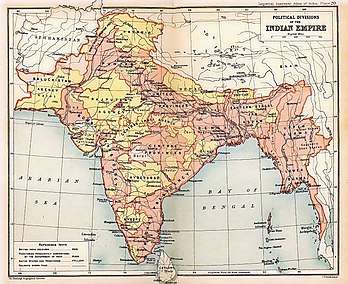
In the British Empire the Indian Princely States were technically independent and were technically given their separate independence in 1947 (although the Nizam of Hyderabad indeed opted for independence but could not retain his independence from India). Egyptian Independence in 1922 technically ended a British protectorate in Egypt. Sudan continued to be governed as Anglo-Egyptian Sudan until Sudanese independence in 1956; Britain also had an interest in Egypt until the Suez Crisis was over. Iraq was made a kingdom in 1932. In each case the economic and military reality did not amount to full independence, but a status where the local rulers were British clients. Similarly in Africa (e.g. Northern Nigeria under Lord Lugard), and Malaya with the Federated Malay States and Unfederated Malay States; the policy of indirect rule.
Germany
After France was defeated in the Battle of France, Vichy France was established as a client state of Nazi Germany, which remained as such until 1942 when it was reduced to a puppet government until its liberation in 1944. Germany also established, in its newly conquered Eastern territories, client states including the Slovak Republic, the Croatian State and the Albanian Kingdom.
United States
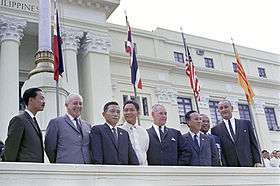
The term applied to authoritarian regimes with close ties to the United States during the Cold War, more appropriately referred to as U.S. proxy states, such as South Vietnam, Indonesia (1966–1998) under the Suharto Regime, Iran until 1979, Cambodia under the regime of Lon Nol from 1970 to 1975, the Philippines under Ferdinand Marcos from 1965 to 1986,[13] and Saudi Arabia. U.S. - Iran relations under the Shah (reigned 1941 to 1979) have been cited as a modern political-science case-study.[14]
A school of thought saw an earlier incarnation of Canada as a client state of the U.S.[15]
The term might also arguably be used for those states extremely economically dependent on a more powerful nation. The three Pacific Ocean countries associated with the United States under the Compact of Free Association (the Federated States of Micronesia, the Marshall Islands and Palau) may fall somewhat in this category.
Japan
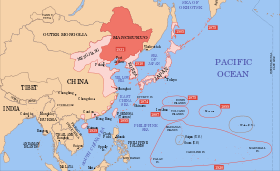
In the late 19th century, the Japanese Empire gradually reduced Joseon Korea's status to that of a client state. In the early 20th century, this was converted to direct rule. Manchukuo, in contrast, remained a puppet state throughout World War II.
Soviet Union
Soviet proxy or "client" states included much of the Warsaw Pact nations whose policies were heavily influenced by Soviet military power and economic aid. Other third world nations with Marxist-Leninist governments were routinely criticized as being Soviet proxies as well, among them Cuba following the Cuban Revolution, the Democratic People's Republic of Korea,[16] the People's Republic of Angola, the People's Republic of Mozambique, the Democratic Republic of Afghanistan, and the Democratic Republic of Vietnam (North Vietnam). Within the Soviet Union itself, the Ukrainian SSR and the Byelorussian SSR, had seats at the United Nations, but were actually proper Soviet territory.
- Warsaw Pact and Comecon states:
.svg.png)
.svg.png)


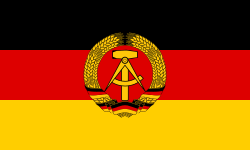

.svg.png)
.svg.png)
.svg.png)


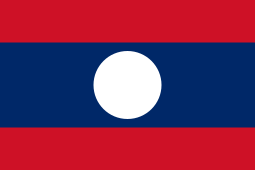

.svg.png)
21st century
Australia

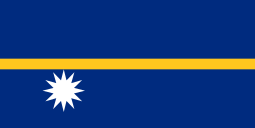
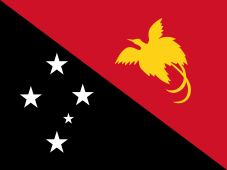
China






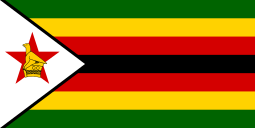
Iran
These countries have to varying degrees been called client states of Iran.
Russia

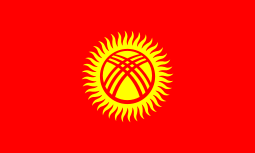



Saudi Arabia


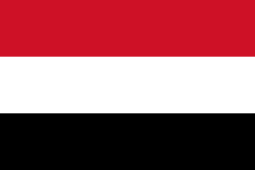
United States
There are three Pacific Island states that are under the Compact of Free Association:
Walter C. Ladwig III, Assistant Professor of International Relations at King's College London, classifies Iraq and Afghanistan as "contemporary client states" of the United States.[53] In 2011 The Atlantic listed Afghanistan, Pakistan, Iraq, Israel, Saudi Arabia, Taiwan, Colombia, South Korea, Yemen and Bahrain as American client states.[54] The term has also been used to describe Ukraine,[55] Georgia,[56] Brazil,[57] Japan,[58] and Australia.[59]
See also
- Protectorate
- Indirect rule
- Vassal state
- Tributary (political)
- Suzerain
- Puppet state
- Banana republic
- Satellite state
References
- Michael Graham Fry, Erik Goldstein, Richard Langhorne. Guide to International Relations and Diplomacy. London, England, UK; New York, New York, USA: Continuum International Publishing, 2002. Pp. 9.
- Rocca, Samuel (2008). Herod's Judaea. ISBN 9783161497179.
- Collected studies: Alexander and his successors in Macedonia, by Nicholas Geoffrey Lemprière Hammond,1994,page 257,"to Demetrius of Pharos, whom she set up as a client king
- Russian Foreign Minister Sergey Sazonov warned Austria in 1914 that Russia "Would respond militarily to any action against the client state." Christopher Clark, The Sleepwalkers: How Europe Went to War in 1914 (2012) p 481.
- Thomas F. X. Noble; et al. (2010). Western Civilization: Beyond Boundaries, Volume C: Since 1789. Cengage. p. 692. ISBN 978-1424069606.
- Michael J. Lyons (2016). World War II: A Short History. Routledge. pp. 3–4. ISBN 9781315509440.
- Barbara Jelavich (2004). Russia and the Formation of the Romanian National State, 1821-1878. Cambridge UP. p. 288. ISBN 9780521522519.
- Clive Ponting (2002). Thirteen Days: The Road to the First World War. Chatto & Windus. p. 60. ISBN 9780701172930.
- Henry Cowper (1990). World War One and Its Consequences. Open University Press. p. 209. ISBN 9780335093076.
- CIRSD Conference on WWI: Panel "What Kind of Failure?" - Prof. Christopher Clark, 21:36. https://www.youtube.com/watch?v=sV2147p9xho Published on 30 May 2014.
- "The French African Connection". Al Jazeera. April 7, 2014. Retrieved September 27, 2018.
- Haski, Pierre (July 21, 2013). "The Return of Françafrique". The New York Times. New York: The New York Times Company. Retrieved September 27, 2018.
- "Imelda's Tears". The New Yorker. April 12, 1998.
- Gasiorowski, Mark J. (1991). U.S. foreign policy and the Shah: building a client state in Iran. Reference, Information and Interdisciplinary Subjects Series. Cornell University Press. ISBN 9780801424120. Retrieved 2018-09-19.
-
Williams, Glen (1989). "6: Canada in the International Political Economy". In Clement, Wallace; Williams, Glen (eds.). The New Canadian Political Economy. Montreal: McGill-Queen's Press - MQUP. pp. 116, 130. ISBN 9780773506817. Retrieved 2018-09-19.
The dependency school, dominant in the 1960s and early 1970s, argued that Canada is an economic colony with a client state. [...] while it might have been possible a decade ago to use a Latin American dependency model when describing Canada, because of its excessive degree of foreign ownership and 'American client state' status, both Canadian capitalists and the Canadian state have now 'come of age.'
- Mizokami, Kyle (8 January 2016). "Why North Korea is betting big on nuclear weapons". The Week.
- James Cogan (25 May 2006). "Australian troops deployed to occupy East Timor - World Socialist Web Site".
- "Info". ro.uow.edu.au. Retrieved 2020-01-13.
- "JPRI Working Paper No. 64".
- "Pacific correspondent Mike Field". Radio New Zealand. 18 June 2015.
- "Chris Kenny visits Nauru as borders open up to allies". The Saturday Paper.
- Wheeler, Tony; Wheeler, Maureen (2008). The Lonely Planet Story. ISBN 9781854584496.
- Ben Doherty. "This is Abyan's story, and it is Australia's story". the Guardian.
- "'Opportunistic' Nauru not fit to sign refugee convention - Crikey".
- "Nauru's former chief justice predicts legal break down". News.
- "Data" (PDF). www.regionalsecurity.org.au. 2010. Retrieved 2020-01-13.
- Ciorciari, John D. "China and Cambodia: Patron and Client?". SSRN Electronic Journal. ISSN 1556-5068.
- Jennings, Ralph. "Impoverished Laos Shows Resistance To Becoming A Client State Of China". Forbes. Retrieved 2020-01-22.
- "China's Myanmar Problem". thediplomat.com. Retrieved 2020-01-23.
- Novick, Rebecca; ContributorWriter; Optimist, Eternal (2010-10-05). "Is Nepal China's Client State?". HuffPost. Retrieved 2020-01-22.
- Standard, The. "(Commentary) North Korea is not a client state that China can control". The Standard. Retrieved 2019-08-02.
- ANI (2018-04-21). "Pakistan is China's client state', says US report". Business Standard India. Retrieved 2020-05-28.
- http://www.chinaafricarealstory.com/2017/11/china-and-zimbabwe-after-mugabe_22.html?m=1
- "Iraq is a Client State of Iran". International Policy Digest. 2017-11-09. Retrieved 2020-01-22.
- Schanzer, Tony Badran and Jonathan (2019-09-18). "Opinion | Lebanon, Hezbollah and Iran's Emerging Client State". Wall Street Journal. ISSN 0099-9660. Retrieved 2020-01-22.
- President Mahmoud Abbas: No To Violence, Terrorism, Gunfire, or Military Intifada. Palestine-pmc.com (28 December 2009). Retrieved on 2010-08-21.
- "Why Is Iran Shipping Arm to Hamas and Hezbollah?". The Blaze. Retrieved 18 May 2016.
- "Iran: The Regional Power behind the Hamas War Effort". Jerusalem Center For Public Affairs. Retrieved 18 May 2016.
- www.idf.il https://www.idf.il/en/minisites/iran/iran-in-syria/the-future-of-irans-presence-in-syria/. Retrieved 2020-01-22. Missing or empty
|title=(help) - Barfi, Barak (2016-01-24). "The Real Reason Why Iran Backs Syria". The National Interest. Retrieved 2020-01-22.
- https://www.middleeastmonitor.com/20150424-saudi-airstrikes-in-yemen-may-have-stopped-but-the-conflict-rages-on/
- "Belarus and Russia ease tensions over oil supplies". www.ft.com. Retrieved 2020-01-16.
- "Cooley: Kyrgyzstan is entering a new era as a Russian client state". www.ponarseurasia.org. 2014-09-19. Retrieved 2020-01-22.
- "With Massive Russian Military Aid, Is Kyrgyzstan Becoming A Client State?". Eurasianet. Retrieved 2020-01-22.
- "New Armenia Will Stay With Russia, If Reluctantly (Op-ed)". The Moscow Times. Retrieved 2020-08-14.
- Knight, Amy (2015-10-08). "Why Russia Needs Syria". The New York Review of Books. Retrieved 2020-01-16.
- "Analysis: Despite Icy Relations With U.S., Could Putin End Syrian War?". NBC News. Retrieved 2020-01-16.
- DeYoung, Karen (2015-09-30). "Obama administration scrambles as Russia attempts to seize initiative in Syria". Washington Post. ISSN 0190-8286. Retrieved 2020-01-16.
- Ben-Ami, Shlomo (2019-11-18). "Is Russia the Middle East's New Hegemon? | by Shlomo Ben-Ami". Project Syndicate. Retrieved 2020-01-16.
- "Former local U.S. Congressman Sweeney defends Russian bank work | The Daily Gazette". dailygazette.com. Retrieved 2020-01-22.
- Fisher, Max (2011-09-21). "Obama's UN Address and the Bahrain Exception". The Atlantic. Retrieved 2020-01-22.
- Shahid, Kunwar Khuldune (2019-02-24). "Pakistan Just Became Saudi Arabia's Client State, and Turned Its Back on Tehran". Haaretz. Retrieved 2020-01-22.
-
Ladwig, Walter C. (2017). The Forgotten Front: Patron-Client Relationships in Counter Insurgency. Cambridge University Press. p. 302. ISBN 9781107170773. Retrieved 2018-05-15.
As with their Cold War counterparts, it was erroneous for American policymakers to believe that the governments of contemporary client states, such as Iraq, Afghanistan, and Pakistan, necessarily shared their desire to defeat radical Islamic insurgents by adhering to the prescriptions of U.S. counterinsurgency doctrine.
- Fisher, Max (2011-09-27). "The Decline of American Client States". The Atlantic. Retrieved 2020-01-21.
- Dubovyk, Volodymyr (2017-02-16). "Is Ukraine a "Client State" of the United States?". PonarsEuarasia - Policy Memos.
- Lieven, Anatol (2007-11-14). "A Tale of Two Client States". The National Interest. Retrieved 2020-01-21.
- "The United States and Brazil: Limits of Influence". 2009-01-28. ISSN 0015-7120. Retrieved 2020-01-22.
- Gittings, John (2007-09-12). "Contradictions of a client state". The Guardian. ISSN 0261-3077. Retrieved 2020-01-22.
- Steger, Isabella. "Australia is at a point where it has to choose between its ally America and its economic backer". Quartz. Retrieved 2020-01-22.